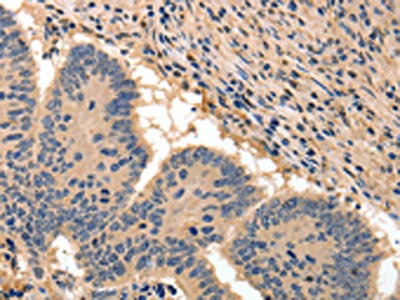
The image on the left is immunohistochemistry of paraffin-embedded Human colon cancer tissue using CSB-PA961022(BAIAP2 Antibody) at dilution 1/50, on the right is treated with fusion protein. (Original magnification: x200)
BAIAP2 Antibody
CSB-PA961022
ApplicationsELISA, ImmunoHistoChemistry
Product group Antibodies
ReactivityHuman, Mouse, Rat
TargetBAIAP2
Overview
- SupplierCusabio
- Product NameBAIAP2 Antibody
- Delivery Days Customer20
- ApplicationsELISA, ImmunoHistoChemistry
- CertificationResearch Use Only
- ClonalityPolyclonal
- ConjugateUnconjugated
- Gene ID10458
- Target nameBAIAP2
- Target descriptionBAR/IMD domain containing adaptor protein 2
- Target synonymsBAI1 associated protein 2; BAP2; brain-specific angiogenesis inhibitor 1-associated protein 2; fas ligand-associated factor 3; FLAF3; insulin receptor substrate of 53 kDa; insulin receptor substrate p53/p58; insulin receptor substrate protein of 53 kDa; IRS-58; IRSP53; IRSp53/58; WAML; WASP and MIM like
- HostRabbit
- IsotypeIgG
- Protein IDQ9UQB8
- Protein NameBrain-specific angiogenesis inhibitor 1-associated protein 2
- Scientific DescriptionThe protein encoded by this gene has been identified as a brain-specific angiogenesis inhibitor (BAI1)-binding protein. This adaptor protein links membrane bound G-proteins to cytoplasmic effector proteins. This protein functions as an insulin receptor tyrosine kinase substrate and suggests a role for insulin in the central nervous system. It also associates with a downstream effector of Rho small G proteins, which is associated with the formation of stress fibers and cytokinesis. This protein is involved in lamellipodia and filopodia formation in motile cells and may affect neuronal growth-cone guidance. This protein has also been identified as interacting with the dentatorubral-pallidoluysian atrophy gene, which is associated with an autosomal dominant neurodegenerative disease. Alternative splicing results in multiple transcript variants encoding distinct isoforms
- ReactivityHuman, Mouse, Rat
- Storage Instruction-20°C or -80°C
- UNSPSC12352203
